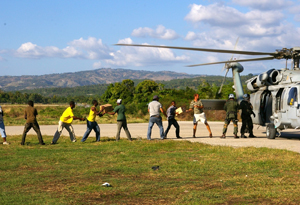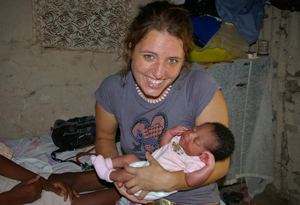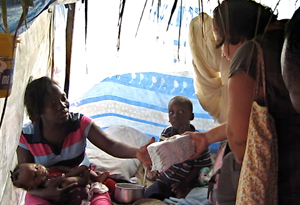Haiti—Filling in the Gaps on the Ground

As founder of the deliberately small international aid organization Global Colors, Barton Brooks is a veritable one-man relief group—a philosophy he calls guerrilla aid. While on the ground in Haiti, he reports on an inspirational, improvisational team of other "guerrilla" warriors making a huge impact on the earthquake-ravaged country.
When the 7.0-magnitude earthquake hit Haiti in January 2010, Nick and Gwenn Mangine (pictured here) grabbed their kids, ran out of their house and immediately went to check on their friends, Danny and Leanne Pye. The Mangines and Pyes had come to Jacmel, Haiti, from North Carolina to create homes for abandoned kids on behalf of the organization Joy in Hope.But neither couple had ever been involved in disaster relief—they were just working to better the lives of a few underprivileged Haitian children. Now, surrounded by the rubble and wreckage of one of the most devastating earthquakes in human history, they found themselves at the forefront of international efforts to deliver aid and save lives.
I learned about the Mangines through a mutual friend and contacted Gwenn shortly after the earthquake, asking her, "Do you need help with anything?"
Minutes later, there was a message in my in-box: "Yes, come down here."

After arriving in the Dominican Republic, I started trying to figure out how to get to Haiti. I met a Spanish-speaking journalist who told me about a Dominican Navy boat willing to take volunteers to Jacmel. We hitched a ride with a few other volunteers headed to the port town of Pedernales and the next morning boarded a boat, "La Tortuguera," along with several hundred tons of food, water and supplies. Six hours later, we arrived in Jacmel and were met by the Mangines, who picked us up and graciously invited us to sleep in a tent in their yard. Due to the aftershocks, it was too dangerous to sleep indoors.
I speak often of "guerrilla aid"—the idea that anyone can do something anywhere—but I've never seen better examples of it than watching the Pyes and Mangines in action. It all started when Nick and Gwenn tried to send their kids back to the United States until things calmed down. They went to the small local airport—which, until recently, handled about a flight per week—to bring in a pilot who could take their kids back to Florida. There was just one problem: The pilot couldn't get clearance to land. "That's because there's no one here!" Nick told him over the phone.
"Just make it over the mountains," he said, "and you'll be okay." Minutes later, a plane was rolling down the runway after a successful landing. That's when Nick and Gwenn realized they could do more than just send their kids home.
In the days that followed, the Mangines and the Pyes took over airport operations. They landed one, then two, then up to 100 planes a day. They even authorized the U.N. planes and dignitaries to land. They hired (out of their own pockets) 25 local men to unload supply planes (pictured here unloading relief supplies in a "bucket brigade" line) and were the main point of contact for the Canadian military, which set up its headquarters at the airport. When the Canadian Disaster Aid Relief Team (DART) arrived, they set up their base on land that Joy in Hope had planned as a school for 800 orphaned kids. Several days ago at the DART field hospital, a healthy baby was born.
By the time I got here, hundreds of little planes were arriving with international goodwill provisions—but with no plan for distributing them. So the Pyes and Mangines called local groups and pastors to get lists of everyone in the region. They hired trucks and more workers, and before long, the U.N. World Food Program was asking them to take over the entire region east of Jacmel. To date, they've distributed some 100 tons of aid—more than any other private group in the area.
I speak often of "guerrilla aid"—the idea that anyone can do something anywhere—but I've never seen better examples of it than watching the Pyes and Mangines in action. It all started when Nick and Gwenn tried to send their kids back to the United States until things calmed down. They went to the small local airport—which, until recently, handled about a flight per week—to bring in a pilot who could take their kids back to Florida. There was just one problem: The pilot couldn't get clearance to land. "That's because there's no one here!" Nick told him over the phone.
"Just make it over the mountains," he said, "and you'll be okay." Minutes later, a plane was rolling down the runway after a successful landing. That's when Nick and Gwenn realized they could do more than just send their kids home.
In the days that followed, the Mangines and the Pyes took over airport operations. They landed one, then two, then up to 100 planes a day. They even authorized the U.N. planes and dignitaries to land. They hired (out of their own pockets) 25 local men to unload supply planes (pictured here unloading relief supplies in a "bucket brigade" line) and were the main point of contact for the Canadian military, which set up its headquarters at the airport. When the Canadian Disaster Aid Relief Team (DART) arrived, they set up their base on land that Joy in Hope had planned as a school for 800 orphaned kids. Several days ago at the DART field hospital, a healthy baby was born.
By the time I got here, hundreds of little planes were arriving with international goodwill provisions—but with no plan for distributing them. So the Pyes and Mangines called local groups and pastors to get lists of everyone in the region. They hired trucks and more workers, and before long, the U.N. World Food Program was asking them to take over the entire region east of Jacmel. To date, they've distributed some 100 tons of aid—more than any other private group in the area.

But they couldn't distribute food and run the airport at the same time, so they transferred that responsibility to Tiffany Keenan, an ER doctor from Canada, and Sarah Wallace (pictured), 24-year-old midwife and who is fluent in Creole and is preparing to open her own maternity center here in Jacmel. Tiffany, a kind of one-woman relief agency, was sending out medical needs lists and matching the incoming supplies to the clinic or hospital that needed it most.
Meanwhile, Sarah did the rest—everything from scheduling flights and managing security, to running "customs" and greeting arriving dignitaries. On several occasions, I heard someone ask a question to Maj. Kevin Skirrow, the Canadian Forces' commanding officer, and he'd shoot back, "Ask Sarah..."
I watched her in action, flipping between English and Creole. "Sarah, I need a translator."
"Okay, I'll get you one."
"Sarah, I need a truck."
"Okay, I'll arrange it."
"Sarah, do you have the number for the mayor?"
"Hold on—it's 372..."
For the first few days, I walked around utterly dumbfounded. Here I am, I thought, with these "house parents" who are now collecting and distributing thousands of pounds of food and two young women charged with coordinating all the private aid—often advising the military on how to streamline their operations.
Not surprisingly, these people have invaluable to my work here. If I need to distribute ceramic water filters, they have a guy with a truck. Travel to a remote village? They have a translator. Despite this being my first time in Haiti and my first attempt at disaster relief, I've been able to accomplish everything I've set out to do, and all because of them.
Meanwhile, Sarah did the rest—everything from scheduling flights and managing security, to running "customs" and greeting arriving dignitaries. On several occasions, I heard someone ask a question to Maj. Kevin Skirrow, the Canadian Forces' commanding officer, and he'd shoot back, "Ask Sarah..."
I watched her in action, flipping between English and Creole. "Sarah, I need a translator."
"Okay, I'll get you one."
"Sarah, I need a truck."
"Okay, I'll arrange it."
"Sarah, do you have the number for the mayor?"
"Hold on—it's 372..."
For the first few days, I walked around utterly dumbfounded. Here I am, I thought, with these "house parents" who are now collecting and distributing thousands of pounds of food and two young women charged with coordinating all the private aid—often advising the military on how to streamline their operations.
Not surprisingly, these people have invaluable to my work here. If I need to distribute ceramic water filters, they have a guy with a truck. Travel to a remote village? They have a translator. Despite this being my first time in Haiti and my first attempt at disaster relief, I've been able to accomplish everything I've set out to do, and all because of them.

One experience in particular stands out in my mind. The other day, I asked Gwenn to accompany me on a visit to Pinchinat, Jacmel's largest refugee site. There, about 7,000 people live in "tents" fashioned from sticks and rags. As we walked around, I watched people's faces light up with surprise at hearing this "blanc" ask, in perfect Creole, "How can we help you?"
Gwenn decided to take packets of diapers from her own orphanage and hand them out to women in the camp (pictured). After half an hour of walking through the muddy lanes, we met a woman and her baby, named Patricia. Gwenn noticed that Patricia, tiny and listless, was unable to cry though she appeared to be trying. The mother explained that Patricia had been throwing up for days and was severely dehydrated. "Let's go," Gwenn said.
In five minutes, we were back in Gwenn's truck with Patricia and her mom, headed to the St. Michel Hospital on the other side of town. As luck would have it, the doctors on duty were staying in Gwenn's guest house, so as we arrived they let us straight into the ward and put baby Patricia on an IV. Within minutes, she had perked up noticeably, her big brown eyes filling with life.
To me, Gwenn's actions epitomize guerrilla aid. Like her family and friends, she understands that she can't do anything on the scale of, say, Doctors Without Borders. But by keeping her eyes and heart open, she found a need, a gap in the larger efforts, and she filled it. She made a difference.
Barton Brooks is an international aid administrator and founder of the nonprofit volunteer organization Global Colors. His mission is to establish sustainable grassroots humanitarian aid projects around the world without the subjugating factors of time or previous experience. He calls this style of work "guerrilla aid." For more information, visit GlobalColors.org and GuerrillaAid.com.
Gwenn decided to take packets of diapers from her own orphanage and hand them out to women in the camp (pictured). After half an hour of walking through the muddy lanes, we met a woman and her baby, named Patricia. Gwenn noticed that Patricia, tiny and listless, was unable to cry though she appeared to be trying. The mother explained that Patricia had been throwing up for days and was severely dehydrated. "Let's go," Gwenn said.
In five minutes, we were back in Gwenn's truck with Patricia and her mom, headed to the St. Michel Hospital on the other side of town. As luck would have it, the doctors on duty were staying in Gwenn's guest house, so as we arrived they let us straight into the ward and put baby Patricia on an IV. Within minutes, she had perked up noticeably, her big brown eyes filling with life.
To me, Gwenn's actions epitomize guerrilla aid. Like her family and friends, she understands that she can't do anything on the scale of, say, Doctors Without Borders. But by keeping her eyes and heart open, she found a need, a gap in the larger efforts, and she filled it. She made a difference.
Barton Brooks is an international aid administrator and founder of the nonprofit volunteer organization Global Colors. His mission is to establish sustainable grassroots humanitarian aid projects around the world without the subjugating factors of time or previous experience. He calls this style of work "guerrilla aid." For more information, visit GlobalColors.org and GuerrillaAid.com.



